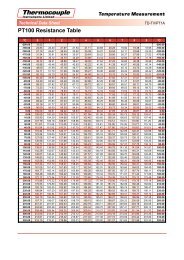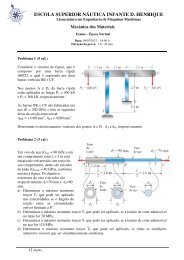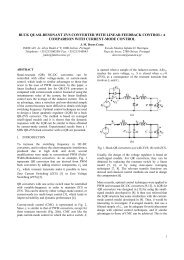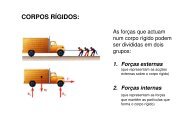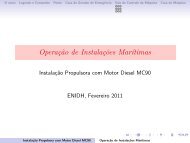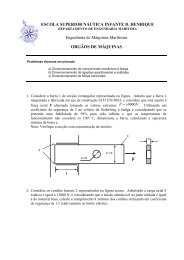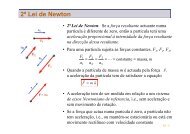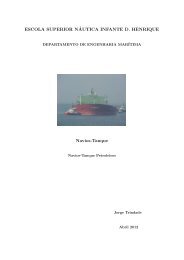Textos de Apoio (pdf)
Textos de Apoio (pdf)
Textos de Apoio (pdf)
Create successful ePaper yourself
Turn your PDF publications into a flip-book with our unique Google optimized e-Paper software.
As an example for an 80,000 dwt cru<strong>de</strong><br />
oil tanker, with a service ship speed of<br />
14.5 knots and a maximum possible<br />
propeller diameter of 7.2 m, this influence<br />
is shown in Fig. 9.<br />
Pitch p<br />
Slip<br />
According to the blue curve, the maximum<br />
possible propeller diameter of 7.2<br />
m may have the optimum pitch/diameter<br />
ratio of 0.70, and the lowest possible<br />
shaft power of 8,820 kW at 100<br />
r/min. If the pitch for this diameter is<br />
changed, the propulsive efficiency will<br />
be reduced, i.e. the necessary shaft<br />
power will increase, see the red curve.<br />
d<br />
0.7 x r<br />
r<br />
n<br />
The blue curve shows that if a bigger<br />
propeller diameter of 7.4 m is possible,<br />
the necessary shaft power will be reduced<br />
to 8,690 kW at 94 r/min, i.e. the<br />
bigger the propeller, the lower the optimum<br />
propeller speed.<br />
The red curve also shows that propulsion-wise<br />
it will always be an advantage<br />
to choose the largest possible<br />
propeller diameter, even though the<br />
optimum pitch/diameter ratio would<br />
involve a too low propeller speed (in relation<br />
to the required main engine speed).<br />
Thus, when using a somewhat lower<br />
pitch/diameter ratio, compared with the<br />
optimum ratio, the propeller/ engine<br />
speed may be increased and will only<br />
cause a minor extra power increase.<br />
The apparent slip ratio S A<br />
, which is<br />
dimensionless, is <strong>de</strong>fined as:<br />
p n V<br />
S = × − V<br />
= 1−<br />
A<br />
p×<br />
n p×<br />
n<br />
V or V A<br />
p x n<br />
p x n _ V<br />
The apparent slip ratio : S<br />
A<br />
= = 1 _<br />
p x n<br />
p x n<br />
The real slip ratio : S<br />
R<br />
= _ VA<br />
= 1 _<br />
p x n<br />
Fig. 10: Movement of a ship´s propeller, with pitch p and slip ratio S<br />
S x p x n<br />
V<br />
p x n<br />
VA<br />
p x n<br />
The apparent slip ratio S A<br />
, which is calculated<br />
by the crew, provi<strong>de</strong>s useful<br />
knowledge as it gives an impression of<br />
the loads applied to the propeller un<strong>de</strong>r<br />
different operating conditions. The apparent<br />
slip ratio increases when the<br />
Operating conditions of a propeller<br />
Slip ratio S<br />
If the propeller had no slip, i.e. if the<br />
water which the propeller “screws”<br />
itself through did not yield (i.e. if the<br />
water did not accelerate aft), the propeller<br />
would move forward at a speed<br />
of V = p × n, where n is the propeller’s<br />
rate of revolution, see Fig. 10.<br />
Velocity of corkscrew: V = p x n<br />
Pitch p<br />
V<br />
The similar situation is shown in Fig. 11<br />
for a cork screw, and because the cork<br />
is a solid material, the slip is zero and,<br />
therefore, the cork screw always moves<br />
forward at a speed of V = p × n. However,<br />
as the water is a fluid and does<br />
yield (i.e. accelerate aft), the propeller’s<br />
apparent speed forward <strong>de</strong>creases<br />
with its slip and becomes equal to the<br />
ship’s speed V, and its apparent slip<br />
can thus be expressed as p × n – V.<br />
Corkscrew<br />
Cork<br />
Fig. 11: Movement of a corkscrew, without slip<br />
Wine bottle<br />
n<br />
15


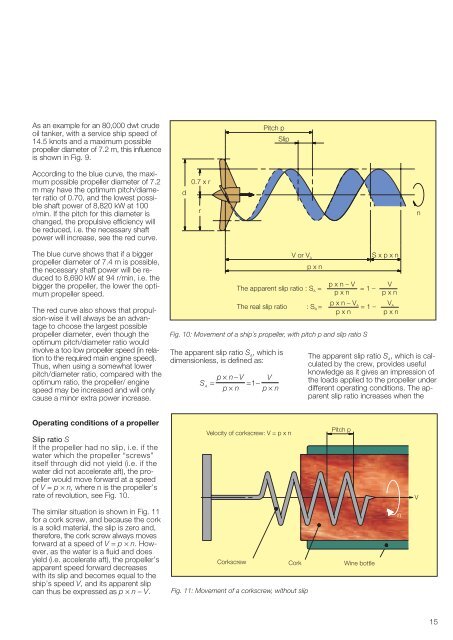
![Conceitos transmissao de dados .Sinais[.pdf]](https://img.yumpu.com/50982145/1/190x146/conceitos-transmissao-de-dados-sinaispdf.jpg?quality=85)
![Packages e interfaces[.pdf]](https://img.yumpu.com/50629553/1/190x134/packages-e-interfacespdf.jpg?quality=85)
